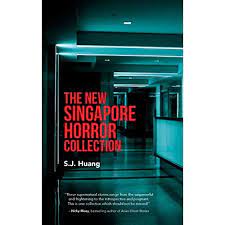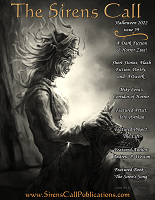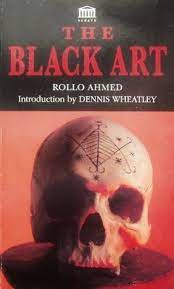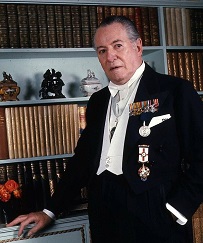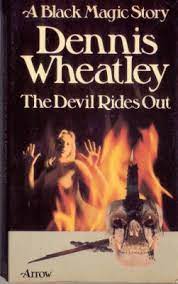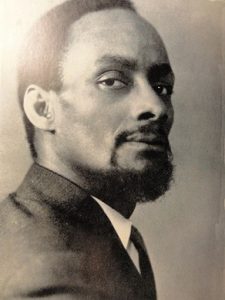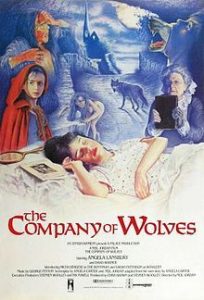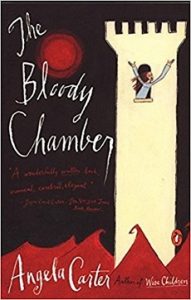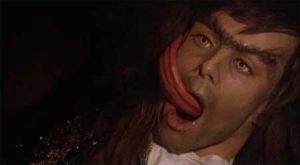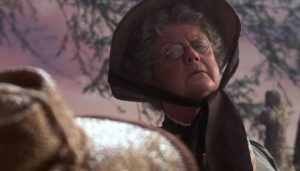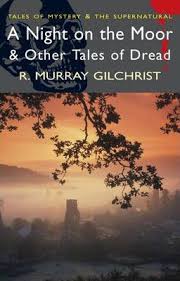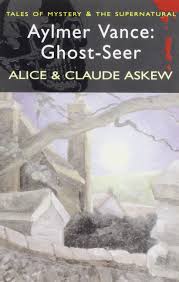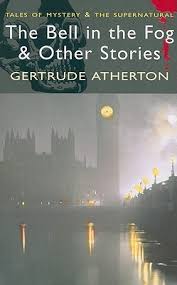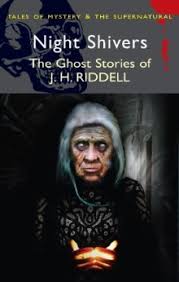
Today is Halloween. As usual, I’ll take advantage of the creepy spirit of the occasion and display ten pieces of macabre art that I’ve come across and liked during the past year.
I’ve sometimes heard the work of the great 18th / 19th German landscape painter Caspar David Friedrich described as ‘occult’ and, yes, there is something strikingly metaphysical in his depictions of puny-looking humans confronted by the huge, bleak awesomeness of nature. I’ve never found his art particularly disturbing, though, until I encountered his 1814 painting The Chasseur in the Forest. It features the always foreboding image of someone – here a lost dragoon – about to venture into a mass of dark, towering, primordial-seeming trees. What awaits him in there? Something cosmically evil and terrifying? Quite possibly.
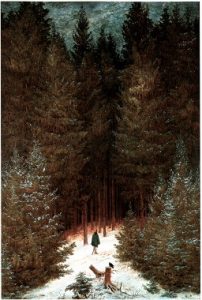
From the sublime to the (splendidly) ridiculous. Here’s a very different rendering of a spooky forest, courtesy of Catalan artist Vincenç Badalona Ballestar, who died in 2014. Ballester was responsible for the covers of many of the schlocky John Sinclair stories – Sinclair, according to Wikipedia, is “the name as well as the protagonist of a popular German horror detective fiction series (of the pulp fiction or penny dreadful variety). Sinclair, a Scotland Yard chief inspector, battles all kinds of undead and demonic creatures. The series appears weekly and has been running since 1973.”
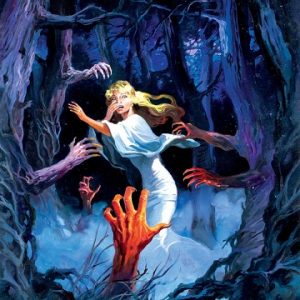
From unquietthings.com
And more, sinister woodland appears in this pen-and-ink work by German artist Fritz Schwimbeck, which was inspired by – I don’t know if it actually illustrated an edition of – Bram Stoker’s Dracula (1897). Drawn in 1917, it presumably depicts the bit near the beginning where Jonathan Harker is picked up by the Count’s mysterious coach and coachman. The tiny scale allowed for pictures on this blog doesn’t do justice to the glorious detail of the picture so, to appreciate it properly, please go to this entry on the horror-art website Monster Brains.
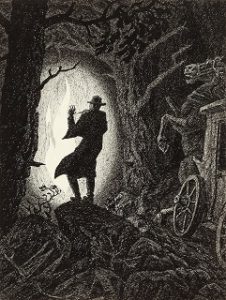
From monsterbrains.blogspot.com
Speaking of Dracula, I feel I should show something by Swiss-born, UK-based artist Oliver Frey, who passed away in August this year. As a kid, I was very familiar with Frey’s work, since it adorned the covers of Hamlyn Books’ compendiums – ‘encyclopaedias’ is rather too sensible a word for them – of spooky stuff aimed at juvenile readers: The Hamlyn Book of Horror (1976), Hamlyn Book of Ghosts (1978), Hamlyn Book of Mysteries (1983) and Hamlyn Book of Monsters (1984). These commonly featured monsters and supernatural creatures of popular folklore and popular culture glaring out from their covers and going “Grrrr!”, as frighteningly as was permitted for children at the time. I recall Dracula on the cover of The Hamlyn Book of Monsters having a stake stuck, surprisingly bloodily, in his chest. Here’s a later picture by Frey of the vampirical Count, this time from the cover of issue 32 of Fear magazine in 1991. It’s done with Frey’s impressively melodramatic and sinewy flair.
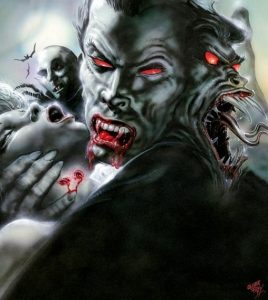
© Newsfield / Oliver Frey
There’s more biting, and painful-looking clawing, going on in this work by the 19th / 20th century Polish painter Boleslaw Biegas, whose output included – I’m quoting Wikipedia again – “mythical, monstrous and female chimeras, which symbolised a battle of the sexes.” That’s a battle that the female chimera in this graphic and muscular picture is definitely winning. It’s entitled Le Baiser du Vampire, but come on – that’s not a vampire, but a harpy, a half-woman, half-bird creature from Greek mythology, who tormented the hapless King Phineus in the legend of Jason and the Golden Fleece. You may be able to see this picture for real in the Polish Library in Paris, which contains the Boleslaw Biegas Art Collection.
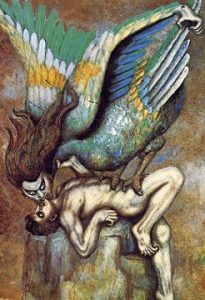
From Greek mythology to Norse mythology. I like this elegant, anime-style depiction of Hel, the female goddess of death who rules the Norse underworld, which appears in the book Norse Gods (2017) by Swedish illustrator Johan Egerkrans. But who’s the giant, fearsome-looking canine beside her? Is it her brother Fenrir, the monstrous wolf who, it’s prophesised, will gobble up the sun on Ragnarōk, the Norse Day of Judgement? Both Hel and Fenrir were the off-spring of the giantess Angerboda and sneaky trickster god Loki, presumably before Tom Hiddleston started to play him in the Marvel superhero movies.
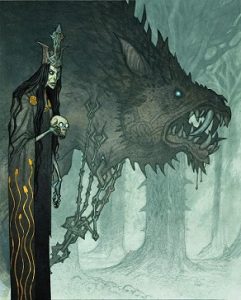
In Christian mythology, Loki’s nearest equivalent is of course Satan, which brings me to my next pick. This is The Devil Skating When Hell Freezes Over, by the 19th / 20th century English Pre-Raphaelite painter John Collier – no relation to the writer John Collier, famous for his sardonic short stories, who was born 50 years later. I like this painting not only for its cheekiness – I love how that tail slips out through the split in the back of the overcoat – but also because it seems to be an ironic riposte to the celebrated painting by Henry Raeburn, The Reverend Robert Walker Skating on Duddingston Loch (or The Skating Minister), often cited as Scotland’s most iconic painting.
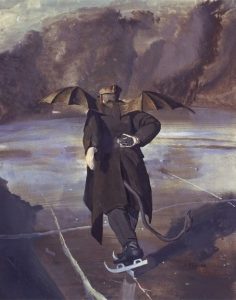
From tumblr.com
Still on the subject of Christian devils, here’s 17th century Italian painter Salvator Rosa’s take on one of the most popular art-subjects in Christendom – The Temptation of St Anthony, which he painted in 1645. Rather than have the long-suffering saint under attack from a whole army of ghoulish creatures, which has been common in other renderings of the story, Rosa provides him with one main adversary. It’s a hideous-looking thing. Although it’s an amalgamation of different animals, with a bird’s body, horse’s skull-head, rat’s tail, boar’s tusks, plus a tiny set of human genitals, these disparate parts meld together and create something that looks disturbingly whole and unified. Indeed, it resembles something that could have crept out of the hold of the space-cargo-ship Nostromo in Alien (1980), had Ridley Scott decided to enlist an Italian Baroque painter to do the production design rather than H.R. Giger.
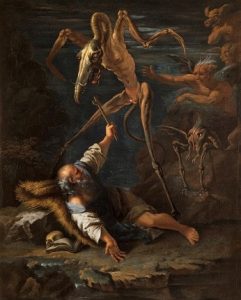
From linusfontrodona.com
This next item, which I believe is the work of modern Turkish artist Soner Çakmak, evokes the devil too. In its subtle, strangely melancholic way, it captures the childhood terror of being alone in your bedroom at night, when you’re still too young to figure out what’s real and what’s imaginary in the world around you. You can especially relate to that feeling if, like me, you spent your childhood somewhere like Northern Ireland in the 1970s, where there were plenty of loud-mouthed, red-faced religious idiots around you assuring you that some frightening concepts indeed, like Satan and his demons in hell, were real.
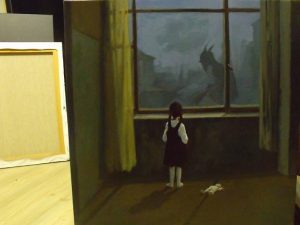
Finally, straight after Halloween comes Mexico’s delightful, skeleton-crazy Day of the Dead festival. In recognition of that, I usually try to include a picture featuring skeletons, bones and skulls. So, here’s an illustration from the 1901 calendar of the Antikamnia Pharmaceutical Company of St. Louis, Missouri, which supplied doctors and druggists with tablets for combatting fevers and reducing pain. It’s one of many skeleton-themed pictures by artist (and doctor) Louis Crusius that the company used in its marketing materials. It seems bizarre that a company peddling a medical product – meant to fight off ill-health – would use such an obvious symbol of death to promote itself. But then, the story of the Antikamnia Pharmaceutical Company was pretty bizarre. It was prosecuted and shut down after the discovery that its tablets contained a banned substance called acetanilide, which reduced the ability of red blood cells to carry oxygen, which among many other bad effects caused takers of the tablets to turn blue.
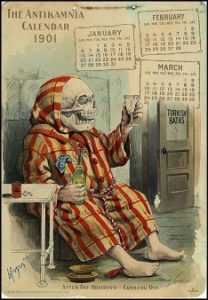
From dangerousminds.net
And that’s it for another year. Happy Halloween!

